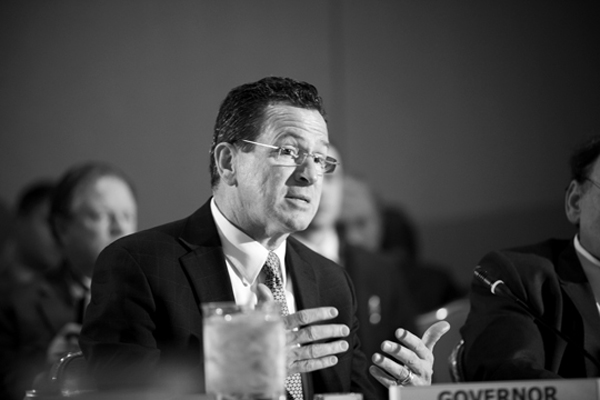Cart before the horse?
In the early 1980s, President Reagan essentially cleared the slate in simplifying the tax code. Now Gov. Dannel P. Malloy gets his chance. The Connecticut Department of Revenue Services (DRS) task force held a public hearing in mid-April as it continues its assessment of business taxes and credits under a Malloy directive. The group will submit recommendations to Malloy in September. A separate committee is analyzing Connecticut”™s patchwork of property taxes. Through March for the fiscal year ending this June, DRS tax collections were running 16 percent above their levels a year prior, with income tax revenue up by a slightly higher margin, and corporation tax collections up nearly 7 percent. At the Hartford hearing, DRS Commissioner Kevin Sullivan said tax cuts should not be the expectation of the committee”™s work, but rather a simplified code that ideally will make it easier for a business to operate in the state. “Our governor”™s been very clear that we have gone through a necessary period of increasing revenue for the state of Connecticut,” Sullivan said. “He”™s been equally clear that that”™s over ”“ that we are now at a point where those adjustments are going to have to come on the spending side.” Any change could involve expanding some tax credits reserved for corporations to limited liability companies and other entities structured to pass profits through to partners. “By more than a 10-to-1 margin, the new businesses that are being formed in Connecticut are pass-through entities,” said Alan Lieberman, a tax expert in the Hartford office of Shipman and Goodwin. “They are limited liabilities companies, they are limited partnerships ”¦ and they can”™t take advantage of a lot of these tax credits.” Tax traps? Connecticut”™s tax code gives even accountants conniptions, said Patrick Duffany, an accountant in the Glastonbury office of J.H. Cohn L.L.P., who noted the differing sales tax treatments applied to business analysis, business management and business management consulting. Heading into the current fiscal year alone, Connecticut enacted 70 changes affecting the taxes residents and businesses pay. “They really create traps for the unwary,” Duffany said. “A lot of Connecticut businesses are aware of it, but if you are outside Connecticut and you”™re looking to come in, you”™re going to be caught unaware.” Fred Carstensen, director of the Connecticut Center for Economic Analysis at the University of Connecticut, said companies”™ state taxes appear to “change” every time they switch auditors, due to wide disparities in interpreting the rules. “I have heard very, very extensive and explicit complaints, particularly ”¦ (from) independent contractors. I actually know of a business who says he is relocating back to New York, because it”™s cheaper to do business in New York because you know what the rules are ”“ and in Connecticut you never know what the rules are.” Panelists wrestled with the fear that any additional change will only discourage companies already fed up with excessive tinkering with the tax code ”“ particularly in jettisoning tax credits that no longer are producing significant results in the form of state revenue and jobs. That could involve scrapping unused credits still on the books of corporations ”“ for the 2010 fiscal year, DRS tallied nearly $2.2 billion in unused tax credits carried forward to a subsequent tax year. “If we change the rules of the game ”¦ and basically (take) money away from businesses, how are we restoring business confidence?” said Steve Lanza, a University of Connecticut economist. “The state ”¦Â has a credibility problem in doing that.” When Connecticut cut back on the value of a research and development tax credit, it significantly hurt the state”™s reputation, according to John Rathgeber, CEO of the Connecticut Business and Industry Association. “People had made investments based on the existence of that tax credit,” he said. Rathgeber, also a board member of the National Association of Manufacturers, said the debate is kindling even as companies outside Connecticut come to a “recognition that we”™re starting to do some things right.” Wade Gibson, senior policy fellow for Connecticut Voices for Children, said companies typically will give serious consideration to relocating to Connecticut if the state successfully makes the case they will cut costs 30 percent, including the impact of incentives. “In terms of credits, there”™s no question businesses are motivated,” Lieberman said. “I don”™t want to say that tax is the sole motivator for making business decisions ”“ that would be overstating the case ”“ but there is no question they are motivated by tax credits, accelerated depreciation, a lot of the tax benefits that are involved. It impacts how they ultimately can finance and pay for these investments.” Horse-and-buggy problem But the state essentially has a “horse-and-buggy” problem, Gibson said ”“ tax credits enacted to promote industries that are no longer part of Connecticut”™s long-range vision for economic development. “The issue here is that our tax code is tilted backwards,” Gibson said. “The rates and the credits ”“ they stay on the books forever. And so the realities of the day when that credit was passed or that rate was set, they may have no bearing on our reality today, and yet they persist into the present.” Gibson rejected the premise of removing ineffective tax credits as scaring off corporations leery of being able to plan for the future, saying he is only suggesting a process that companies follow themselves ”“ ongoing course corrections based on up-to-date accounting of profits and losses. “I don”™t think a stable waste of money is inherently good,” Gibson said. “If we can”™t spend money ”¦ in a way that ensures the taxpayer gets a good return, then we shouldn”™t spend that money through a credit. We should spend it through a grant or a loan or somewhere else.”
